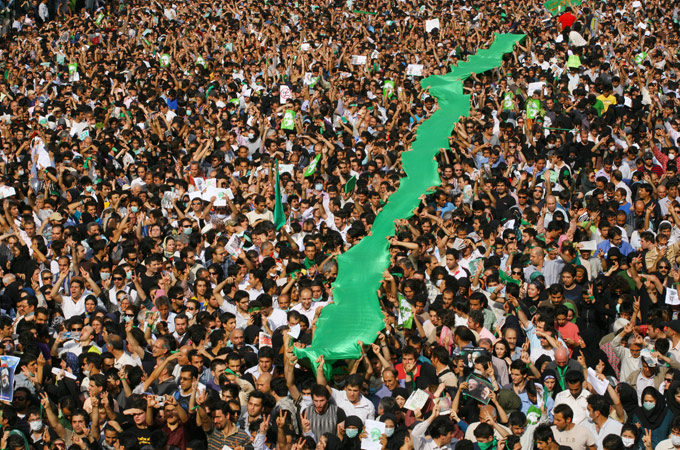Al Jazeera
A look at opposition groups in Iran since the 1979 revolution that toppled the Shah.
Successful opposition movements the world over face opposition after taking power. Iran's Islamic rulers have been no exception to the rule.
Having toppled the autocratic Shah in 1979, the former revolutionaries themselves are now being challenged by groups thirsting for change.
Opposition to them began shortly after the revolution that ended the Shah's reign.
As the nation fought a costly war with Iraq, splits emerged among the once united revolutionary front and the government began a crackdown on dissent in an attempt to consolidate power and bring stability to the nascent Islamic Republic.
Perhaps the most well-known among the early opposition groups was the People's Mujahedeen of Iran (MEK). Despite being closely allied to Ayatollah Khomeini and his supporters throughout the 1970s, the group split from the Supreme Leader soon after the revolution.
n 1981, the conflict between the government and MEK fighters descended into street battles. After the MEK was outlawed, Iraq's Saddam Hussein exploited the group, giving it a base in Iraq and support to wage attacks inside Iran and provide intelligence.
Also among the opposition groups was the Tudeh party, or the "party of the masses". Many Tudeh members were arrested and executed during the 1980s.
In 1981, the Islamic Republic banned all political parties save the Islamic Republic Party. Khomeini later broke up the party in 1985 over internal conflicts; however, only parties that adhered to the Islamic character of the state could operate legally.
Those who held different views paid a heavy price, like Abulhassan Babnisdar, the Islamic Republic's first president. He went into exile after being impeached a year after taking office.
In 1989, another high-profile figure fell foul of the Supreme Leader. Ayatollah Hussein-Ali Montazeri, Khomeini's heir apparent, was fired after he had called for more openness and crticised the crackdown on dissent.
Montazeri was replaced by the more conservative Ayatollah Ali Khameinei, who succeeded Khomeini upon his death in June 1989, and remains Iran’s the Supreme Leader until today.
Aborted reforms
In 1989, soon after the death of Khomeini, Ayatollah Akbar Hashemi Rafsanjani was elected as president for the first of two terms. Rafsanjani, whose critics accuse of widespread corruption, oversaw the period of reconstruction after nearly a decade of the devastating war with Iran.
Then, in 1997, came the election of the reformist Mohammad Khatami in a surprising landslide victory indicating the country was ready for change. However, while Khatami encouraged more openness in Iran, his reformist agenda was limited by the judiciary, which remained controlled by conservatives.
Khatami had tried to increase the president’s powers and limit the power of the Guardian Council, a 12-member council half appointed by the Supreme Leader and half selected by parliament, but was blocked by the powerful body that is able to veto parliament and interpret the constitution.
In 1999, after the nationwide student paper Salam was shut down, students took to the streets. For six days students protested. At least five people were killed and thousands more were injured and arrested. Sporadic protests continued in the following decade among mostly students and workers demanding reforms. But it wasn’t until 2009 that Iranians would, for the first time since the 1979 revolution, witness massive street protests against the government.
The “Green Movement”
Mahmoud Ahmadinejad, a conservative who, ironically, doesn't come from a clerical background like most of his predecessors, was elected to his first term as president in 2005. Ahmadinejad’s first term was characterised by defiance to western-imposed sanctions and threats against Iran.
In 2009, Ahmadinejad stood for re-election against his main challenger, Mir-Hussein Mousavi. Mousavi, who served as the Islamic Republic’s first and only prime minister from 1979 until the office was abolished in 1989, was a close ally of former president Khatami and ran as the main reform candidate.
In the lead up to the elections Mousavi held a number of energetic rallies. Mousavi’s supporters dressed themselves in green scarves, wristbands and other items as they paraded in the streets of Iranian cities to show support for the reform candidate.
Despite the visible display of support for Mosuavi, Ahmadinejad emerged from the June elections as the nationwide winner with over 64 per cent of the vote; Mousavi finished second with just under 34 per cent.
On June 13, one day after the elections, protesters turned out in the hundreds of thousands across the country, many chanting and carrying signs around the theme, “where is my vote?” Mousavi’s supporters went from being known as the “Green Wave” to the “Green Movement” and the government responded by ordering a crackdown. More than 100 people were killed and thousands of people were arrested during the protests that lasted for weeks.
Over the next few months, a number of arrested protesters faced trial and many were hanged. Many pro-reform and independent papers were shut down as protests continued. When Ayatollah Montazeri died in December, his funeral became a rallying point with tens of thousands of mourners chanting against the governement. However, by February 11, 2010, the anniversary of the 1979 revolution, the months of uprising seemed effectively crushed.
One year later, in February 2011, the opposition called for protests in solidarity with the uprisings that were then happening in a number of Arab countries. Just before the planned protests, Mousavi and Mehdi Karroubi, another leading pro-reform politician and a candidate in the 2009 elections, were placed under house arrest. Protests happened in a number of cities for a little over a week, and again hundreds were injured and arrested during the crackdown.
When Iranians go to the polls to elect fresh members of parliament on March 2, they will do so without the major reform candidates on the ballots. Most pro-reform groups are calling for boycott, but some individuals will run as independents. The battle in this election is seen as largely between the conservative camps.


No comments:
Post a Comment